Dryer No. 10


LOCATION: Dehra Dun, U.P., INDIA
(Latitude 30 N; longitude 78 E)
STATUS: Operational
TYPE: Greenhouse with three walls and the roof transparent
HEATING SYSTEM: Solar hot air collectors; double covering of glass 7/32-inch (0.55 cm) thick on the outside; polyethylene sheet 0.01-inches (0.025 cm) on the inside with a gap of 1-1/2 inches (3.7 cm) between the glass and plastic; blackened metal absorber inside dryer
CIRCULATION: Two 36-inch (91 cm) diameter fans; 1 kW each
VENTILATION: Intake vent near bottom of south wall; exhaust vent near bottom of north wall; part of north wall can be removed to have dryer act as a single pass system rather than as a recirculation system
CAPACITY: 3000 board feet (7.1 cubic meters)
COLLECTOR AREA TO CAPACITY RATIO: 80 square feet per thousand board feet (3.1 square meters per cubic meter)
LOADING: Door in east (and west?) wall
Dryer No. 11
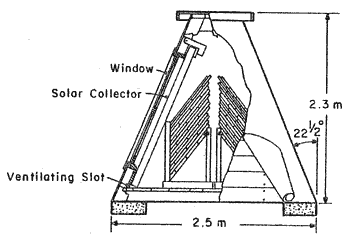
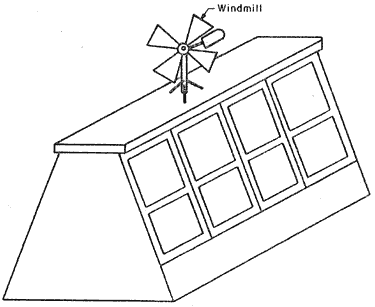
LOCATION: Dodgeville, Wisconsin, USA
(Latitude 43 N; longitude 90 W)
STATUS: Small scale production since 1958
TYPE: Semi-greenhouse
HEATING SYSTEM: Solar hot air collectors; single layer of glass; black painted metal absorber several inches under the glass
CIRCULATION: One 14-inch (36 cm) centrifugal fan just underneath the roof driven by a windmill; windmill is 54-inches (137 cm) in diameter
VENTILATION: Small slot in the floor
CAPACITY: 400 board feet (0.9 cubic meters)
COLLECTOR AREA TO CAPACITY RATIO: 93 square feet per thousand board feet (3.7 square meters per cubic meter)
LOADING: Hand loaded through hinged door on rear (north) wall
OVERALL DIMENSIONS: East-west, ca. 8-ft (2.4 m); north-south 8.2-ft (2.5 m); overall height, 7.6-ft (2.3 m)
CONSTRUCTION: Framed with 2 x 4 and 2 x 6 framing covered with 1-inch boards and roofing felt
STORAGE: None
PERFORMANCE: Drying time for a mixed load of cherry (16% MC to 8% MC) and white oak (60% MC to 6%MC) 1-inch (2.5 cm) thick is 52 days during warm weather
Drying time for black cherry 4/4-inches (2.5 cm) thick from 50% MC to 20% MC is 75 days (wintertime) and from 20% MC to 8% MC is 20 days. No checking; lumber was bright
REFERENCES:
Article – Johnson, C. L. 1961. Wind-powered solar-heated lumber dryer. Southern Lumberman (October 1)
Dryer No. 12
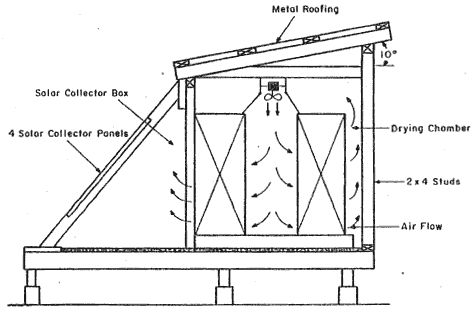
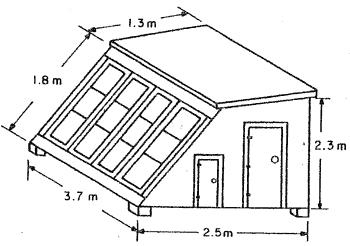
Location: Dodgeville, Wisconsin, USA
(Latitude 48 N; longitude 90 W)
STATUS: Operational
TYPE: Semi-greenhouse
HEATING SYSTEM: Solar hot air collector; single glass glazing; black painted metal absorber about 2-inches below glazing
CIRCULATION: Two overhead fans, spaced evenly; 1200 cubic feet of air per minute each (0.6 cubic meters per second)
VENTILATION: Two openings in the floor, each 4 x 10-inches (10 x 25 cm) located in the central plenum; two vents at the bottom of the collector, 3 x 8-inches (8 x 20 cm)
CAPACITY: 850 board feet (1.9 cubic meters)
COLLECTOR AREA TO CAPACITY RATIO: 56 square feet per thousand board feet (2.2 square meters per cubic meter)
LOADING: Manually through door in east wall
OVERALL DIMENSIONS: East-west, ca. 8-ft (2.4 m); north-south, ca. 10-ft (2.5 m); height, ca. 6.5-ft (2 m)
CONSTRUCTION: Wood 2 x 4 framing with lumber siding and ¾-inch (1.9 cm) plywood flooring; metal roof; 2 x 4 framing for collector with windows of 1 x 6 lumber supports; glazing is 8 pieces of 24 x 26-inches (61 x 66 cm) for lower two sections and 4 pieces of 24 x 16-inches (61 x 41 cm)
STORAGE: None
PERFORMANCE: Drying time for a mixed load of black cherry, 4/4-inches (2.5 cm) thick, from 60% MC to 6% MC: and white oak, 4/4-inches (2.5 cm) thick, from 16% MC to 7% MC is 52 days in summer
Drying time for a mixed load of cottonwood, 8/4-inches (5 cm) thick, from 130% MC to 10% MC; and black walnut, 4/4-inches (2.5 cm) thick, from 85% MC to 12% MC is 47 days in the summer
Drying time for black cherry, 4/4-inches (2.5 cm) thick, from 50% MC to 8% MC is 218 days in winter and spring. No drying defects were noted
REFERENCES:
Article – Bois, P. J. 1977. Constructing and operating a small solar-heated lumber dryer. USDA Forest Service State and Private Forestry Forest Products Utilization Technical Report No 7. (Madison) 12p.
Dryer No. 13


LOCATION: Fort Collins, Colorado, USA
(Latitude 41 N; longitude 105 W)
STATUS: Experimental (1965-1974)
TYPE: Greenhouse with transparent roof and 3 walls
HEATING SYSTEM: Solar hot air collectors with a single layer of corrugated fiberglass reinforced polyester; everything inside the dryer painted flat black
Dryer No. 14

LOCATION: Griffith, New South Wales, AUSTRALIA
(Latitude 34 S; longitude 146 E)
STATUS: Experimental
TYPE: Opaque walls
HEATING SYSTEM: Solar hot air collectors; single glass layer; black painted copper clad steel, v-groove absorber
VENTILATION: One intake vent in the south wall and one discharge vent in the north wall.
CAPACITY: 2800 board feet (6.5 cubic meters)
CAPACITY TO COLLECTOR AREA RATIO: 220 square feet per thousand board feet (8.7 square meters per cubic meter)
LOADING: Track loaded from sides
OVERALL DIMENSIONS:
Chamber - east-west, 15.6-ft (4.77 m); north-south, 11.6-ft (3.54 m); height, 8.4-ft (2.55 m)
Collector – east-west, 57-ft (17.5 m); sloped height, 10.5-ft (3.2 m)
CONSTRUCTION: Chamber – prefabricated aluminum panels
Collector – standard flat plate collector construction; insulated ducts connect collector to kiln
STORAGE: A chamber under the kiln of the same dimension as the kiln contains 550 cubic feet (15.5 cubic meters) of crushed basalt
PERFORMANCE: Drying time for alpine ash (Eucalyptus) 4/4-inch (2.5 cm) thick from 100% MC to 6% MC is 20 days with kiln approximately half full
REFERENCES:
Article – Read, W. R., A. Choda and P. I. Copper. 1974. A solar timber kiln. Solar Energy 15:309-316
Dryer No. 15


LOCATION: Homer, Alaska, USA
(Latitude 60 N; longitude 152 W)
STATUS: Operational
TYPE: Semi-greenhouse; only roof is transparent
HEATING SYSTEM: Solar hot air collectors; corrugated fiberglass polyester glazing; interior of dryer is painted black
CIRCULATION: One fan; 1/15 horsepower motor; return air plenum with 7 openings into the kiln is on the outside, bottom of north wall; fan blows in one opening at top and downward along collector; fans only operate above 65 F (18 C)
VENTILATION: Manually operated vents in rear wall return plenum
CAPACITY: 2000 board feet (4.7 cubic meters)
CAPACITY TO COLLECTOR AREA RATIO: 85 square feet per thousand board feet (3.3 square meters per cubic meter)
LOADING: Manually through doors on east and west walls
OVERALL DIMENSIONS: East-west, 18-ft (5.5 m); north-south, 6.75-ft (2 m); height, 9.5-ft (2.9 m)
CONSTRUCTION: Frame construction with 2 x 4 framing; flooring with 2 x 8 framing; 5/8 inch (1.6 cm) plywood on exterior walls; 3/8-inch (1 cm) plywood on interior walls; 3-5/8-inch fiberglass insulation in walls and floor
STORAGE: None
PERFORMANCE: Dries to 7-1/2% MC
REFERENCES:
Article – Anon. Ca. 1982. Solar kiln to dry wood. Alaska Council on Science and Technology (Juneau). 6p.
Present Contact: Bruce Forster
PO Box 1021
Homer, Alaska 99603
USA
Dryer No. 16
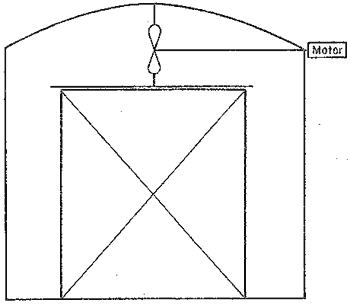
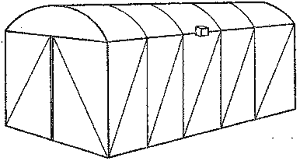
LOCATION: Kampala, UGANDA
(latitude 0 N; longitude 33 W)
STATUS: Experimental
TYPE: Greenhouse; all four walls and the roof are transparent
HEATING SYSTEM: Solar hot air collectors; two layers of plastic film 1-3/4-inches (4.4 cm) apart; two aluminum reflectors – ca. 6 x 15-ft (1.8 x 4.6 m) – one on each side outside the kiln reflect additional energy; reflectors are adjusted hourly
CIRCULATION: Two 18-inch (45 cm) diameter electric fans; reversible
VENTILATION: Two vents, one at each end act as inlet or outlet depending on fan direction.
CAPACITY: 1400 board feet (3.3 cubic meters)
CAPACITY TO COLLECTOR AREA RATIO: 62 square feet per thousand board feet (2.4 square meters per cubic meter)
LOADING: Door at end
OVERALL DIMENSIONS: East-west, 6-ft (1.8 m); north-south, 15-ft (4.6 m); height, 4-ft (1.2 m); all dimensions are internal sizes
CONSTRUCTION: Lumber framing; concrete floor; all surfaces painted black
STORAGE: None
PERFORMANCE: Drying time for Sterculia dawei 4/4-inch (2.5 cm) thick from 112% MC to 12% MC is 27 days
Drying time for Erythrophleum guineense 4/4-inch (2.5 cm) thick from 50% MC to 15% MC is 41 days Quality better than air drying
REFERENCES:
Article – Plumptre, R. A. 1967. The design and operation of a Commonwealth Forestry Review 46(4): 298-309.
Dryer No. 17


LOCATION: Madison, Wisconsin, USA
(Latitude 43 N; longitude 89 W)
STATUS: Experimental
TYPE: Greenhouse
HEATING SYSTEM: Solar hot air collectors; two layers of plastic film; black painted metal absorber 1-1/2 inches (4 cm) from plastic
CIRCULATION: One 24-inch (61 cm) electric fan powered by 5/8 horsepower motor; located near roof
VENTILATION: Two vents each on east and west walls; each vent is 8-inches (20 cm) in diameter; located near floor; electrically controlled damper using a wood element hygrostat inside the dryer
CAPACITY: 425 board feet (1.0 cubic meters)
CAPACITY TO COLLECTOR AREA RATIO: 220 square feet per thousand board feet (8.7 square meters pre cubic meter)
LOADING: Doors in north wall; manual
OVERALL DIMENSIONS: East-west, 7.5-ft (2.3 m); north-south, 12.7-ft (3.9 m); height, 8-ft (2.4 m)
CONSTRUCTION: Frame construction with 2 x 4 framing on walls and 2 x 6 on roof; black painted corrugated aluminum on inner framing surfaces; two layers, separated by 2-inches (5 cm) by another frame on outside; rectangular opening in aluminum throughout to provide air flow past both faces of metal; wood framed floor with plywood covering
STORAGE: None
PERFORMANCE: Drying time for red oak, 4/4-inch (2.5 cm) thick, from 75% MC to 20% MC is 34 days in late spring; from 70% MC to 20% MC is 24 days in late summer; and from 80% MC to 20% MC is 105 days in winter Quality superior to air drying
REFERENCES:
Articles – Peck, E. C. 1962. Drying 4/4 red oak by solar heat. Forest Products J 13(3): 103-107.
Peck, E. C. 1962. Drying lumber by solar energy. Sun at Work 7(3):4-6.
Dryer No. 18
Dryer No. 19
LOCATION: North San Juan, California, USA

B: Air Space for Circulation
C: Charcoal Heat Absorber
D: Sand
E: Ground Line
F: Concrete Blocks (Hollow Core)
G: Preservative-Treated Wood Sills
H: Wooden Battens

(Latitude 43 N; longitude 87 W)
STATUS: Prototype (approximately ½ scale) for kilns in Philippines, Burma and Sri Lanka
TYPE: Opaque wall
HEATING SYSTEM: Solar hot air collector; fiberglass reinforced polyester film 0.04-inches (0.1 cm) thick; absorber is granulated charcoal, 1.2-inch (1.25 cm) thick, 6-inches (15 cm) below the glazing; air is circulated in the collector by a ½ horsepower blower.
CIRCULATION: In the dryer, two ½ horsepower fans circulate air through the lumber pile
VENTILATION: Two roof vents
CAPACITY: 1000 board feet (2.36 cubic meters)
COLLECTOR AREA TO CAPACITY RATIO: 200 square feet per thousand board feet (7.9 square meters per cubic meter)
LOADING: Door in north wall of chamber
OVERALL DIMENSIONS: Chamber – east-west, 8-ft (2.5 m); north-south, 9-ft (2.7 m); height, 10-ft (3.0 m)
Collector – east-west, 8-ft (2.5 m); north-south, 25-ft (7.6 m)
CONSTRUCTION: Walls framed with 2 x 4’s with ½-inch (1.25 cm) thick plywood on the inside and 5/8-inch (1.6 cm) thick plywood on the outside; polyethylene vapor barrier on the inside of the wall; fiberglass insulation inside the wall between the framing; roof is similar using 2 x 8 framing and roofing paper
STORAGE: None
PERFORMANCE: Dryer conditions are controlled with electric venting and humidifying equipment to maintain 60% relative humidity Drying time for northern red oak, 4/4-inch (2.9 cm) thick, from 84% MC to 9% MC is 54 days in summer Solar dried lumber had 3.5 times fewer cracks than air dried lumber
REFERENCES:
Articles – Tschernitz, J. L. and W. T. Simpson. 1979. Solar-heated forced-air, lumber dryer for tropical latitudes. Solar Energy 22:563-566
Tschernitz, J. L. and W. T. Simpson. 1977 solar kilns: feasibility of utilizing solar energy for drying lumber in developing countries. USDA Forest Service Forest Products Laboratory unnumbered report. (Madison) 63p.
Present Contact: Dr. John Tschernitz
Forest Products Laboratory
PO Box 5130
Madison, Wisconsin 53705
USA


(Latitude 39 N; longitude 120 W)
STATUS: Operational
TYPE: Semi-greenhouse; south sloped wall only is transparent
HEATING SYSTEM: solar hot air collectors; two layers of fiberglass polyester; black painted metal absorber
CIRCULATION: One 1/3 horsepower motor powered by photo-voltaic panel (24 volts); centrifugal blower
VENTILATION: A 14 x 18-inch (36 x 46 cm) louvered vent near the top of the east and west walls for intake; a vent pipe in the roof with electrically operated damper for exhaust
CAPACITY: 3000 board feet (7 cubic meters)
CAPACITY TO COLLECTOR AREA RATIO: 83 square feet per thousand board feet (3.3 square meters per cubic meter)
LOADING: Fork lift loaded through removable panels in north wall
OVERALL DIMENSIONS: East-west, 20-ft (6.1 m); north-south, 16-ft (4.9 m); height, 16-ft (4.9 m)
CONSTRUCTION: Frame construction with 2 x 6 framing; concrete floor and pressure treated wood foundation; lumber siding on exterior; gypsum wallboard on interior
STORAGE: Forty tons of 1 to 3-inch (2.5 to 8 cm) diameter rocks underneath lumber pile
REFERENCES:
Article – Anon. 1982. Solar kiln can dry 3000 bd ft of lumber. Timber/West (March):2627.
Present Contact: Mr. Jeff Gold
PO Box 165
North San Juan, California 95960
USA